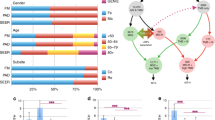Abstract
To gain a better understanding of the biologic development of rectal adenicarcinomas, the authors evaluated the level ofras gene protein product (p21) in the available material of 74 Dukes'B adenocarcinomas, 64 Dukes' C adenocarcinomas, and 60 lymph-node metastases resected at the University of Chicago Medical Center between 1965 and 1981. Pathologic slides and archival paraffin blocks were retrieved for confirmation of the original diagnosis and measurement of p21 content. P21 titers were obtained using the RAP-5 monoclonal antibody in a semiquantitative immunohistochemical assay. Titer was expressed as the highest dilution giving definitive staining using the avidinbiotin peroxidase method. The analysis indicated that a higher percentage of Dukes' stage C rectal adenocarcinomas had high (≥1∶40,000) p21 titers than Dukes' B adenocarcinomas (68.8vs. 51.4 percent, respectively,P<0.05). In view of recent data suggesting thatras oncogene expression confers invasive and metastatic capabilities to NIH 3T3 cells, the authors believe this study offers evidence that overexpression ofras oncogene with overproduction of p21 protein product may be an important prerequisite for the acquisition of metastatic capabilities in the early stages of colon cancer.
Similar content being viewed by others
References
Nicholoson GL. Cancer metastasis: organ colonization and cell-surface properties of malignant cells. Biochem Biophys Acta 1982;695:113–76.
Nicholoson GL, Poste G. Tumor implantation and invasion at metastatic sites. Int Rev Exp Pathol 1983;25:77–181.
Poste G, Fidler IH. The pathogenesis of cancer metastasis. Nature 1980;281:73–5.
Roos E. Cellular adhesion, invasion and metastasis. Biochem Biophys Acta 1984;738:263–84.
Cooper GM. Cellular transforming genes. Science 1982;217:801–6.
Der CJ, Krontiris TG, Cooper GM. Transforming genes of human bladder and lung carcinoma cell lines are homologous to the ras genes of Harvey and Kirsten sarcoma viruses. Proc Natl Acad Sci USA 1982;79:3637–40.
Der CJ, Cooper GM. Altered gene products are associated with activation of cellular rask genes in human lung and colon carcinoma. Cell 1983;32:201–8.
Murray MJ, Cunningham JM, Parada LF, Dautry F, Lebowitz P, Weinberg RA. The HL-60 transforming sequence: aras oncogene consisting with altered myc gene in hematopoietic tumors. Cell 1983;33:749–57.
Mareel MM, Bruyneel EA, Dragonetti CH, et al. Effects of temperature on invasion of MO4 mouse fibrosarcoma cells in organ culture. Clin Exp Metastasis 1984;2:107–25.
Mareel M, Dragonetti C, Hooghe R, Bruyneel E, Bracke M, Van Roy F, Gao J, De Bruyne G, Fiers W. Expression of cell surface glycoproteins in tumor invasionin vivo. In: Galeotti T, Cittandini A, Neri G, Papa S, eds. Cell membranes and cancer. Amsterdam: Elsevier Science Publ BV, 1985:43–9.
Collard JG, Van Beek WP, Janssen JW, Schijven JF. Transfection by human oncogenes: concomitant induction of tumorigenicity and tumor-associated membrane alterations. Int J Cancer 1985;35:207–14.
Thorgiersson UP, Turpeenniemi-Hujanen T, Williams JE, et al. NIH/3T3 cells transfected with human tumor DNA containing activatedras oncogenes express the metastatic phenotype in nude mice. Mol Cell Biol 1985;5:259–62.
Willingham MC, Pastan I, Shih TY, Scolnick EM. Localization of the srg gene product of the Harvey strain of MSV to plasma membrane of transformed cells by electromicroscopic immunocytochemistry. Cell 1980;19:1005–14.
Thor A, Hand PH, Wunderlich D, Caruso A, Moraro R, Schlom J. Monoclonal antibodies define differentialras gene expression in malignant and benign colonic diseases. Nature 1984;311:562–5.
Hand PH, Thor A, Wunderlich D, Muraro R, Caruso A, Schlom J. Monoclonal antibodies of predefined specificity detected activatedras gene expression in human mammary and colonic carcinomas. Proc Natl Acad Sci USA 1984;81:5227–31.
Kerr IB, Lee FD, Quintanilla M, Balmain A. Immunocytochemical demonstration of p21ras family ocongene product in normal mucosa and in premalignant and malignant tumors of the colorectum. Br J Cancer 1985;52:695–700.
Spandidos DA, Kerr IB. Elevated expression of the humanras oncogene family in premalignant and malignant tumors of the colorectum. Br J Cancer 1984;49:681–8.
Gallick GE, Kurzrock R, Kloetzer WS, Arlinghaus RB, Gutterman JU. Expression of p21ras in fresh primary and metastatic human colorectal tumors. Proc Natl Acad SCI USA 1985;82:1795–9.
Hand PH, Vilasi V, Thor A, Ohuchi N, Schlom J. Quantitation of Harveyras p21 enhanced expression in human breast and colon carcinomas. JNCI 1987;79:59–65.
Astler VB, Coller FA. The prognostic significance of direct extension of carcinoma of the colon and rectum. Ann Surg 1954;139:846–52.
Agresti A. Analysis of ordinal categorical data. New York: John Wiley & Sons, 1984.
Thomas DG. Exact and asynoptic methods for the combination of two-by-two tables. Comput Biomed Res 1975;8:423–46.
Michelassi F, Leuthner S, Lubienski M, et al.Ras oncogene p21 levels parallel malignant potential of different human colonic benign conditions. Arch Surg 1988;121:1414–6.
Hand PH, Thor A, Wunderlich D, Murara R, Caruso A, Schlom J. Monoclonal antibodies of predefined specificity detect activatedras gene expression in human mammary and colon carcinomas. Proc Natl Acad Sci USA 1984;81:5227–31.
Williams AR, Piris J, Spandidos DA, Wyllie AH. Immunohistochemical detection of theras oncogene p21 product in an experimental tumor and in human colorectal neoplasms. Br J Cancer 1985;52:687–93.
Kerr IB, Lee FD, Quintanilla M, Balmain A. Immunocytochemical demonstration of p21ras family oncogene product in normal mucosa and in premalignant and malignant tumors of the colorectum. Br J Cancer 1985;52:695–700.
Gallick EG, Kurzrock R, Kloetzen WS, et al. Expression of p21ras in fresh primary and metastatic human colorectal tumors. Proc Natl Acad Sci USA 1985;82:1975–99.
Author information
Authors and Affiliations
Additional information
Supported in part by Award#87-100 of the American Cancer Society.
About this article
Cite this article
Michelassi, F., Erroi, F., Roncella, M. et al. Ras oncogene and the acquisition of metastasizing properties by rectal adenocarcinoma. Dis Colon Rectum 32, 665–668 (1989). https://doi.org/10.1007/BF02555770
Issue Date:
DOI: https://doi.org/10.1007/BF02555770




